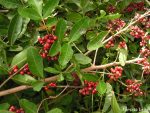
Also called Christmasberry tree and Florida holly, this evergreen shrub or small tree is a member of the cashew family, Anacardiaceae, that also includes poison ivy, sumac, and smoke tree. It is native to Argentina, Paraguay, and Brazil but was introduced to the US by the mid 1800s as an ornamental and has become invasive in Florida, Texas, California, Hawaii, and Puerto Rico. Plants grow up to 30’ from a shallow root system and have upright or sprawling branches and pinnately compound leaves with 5-15 ellipitical, finely toothed leaflets 1-2” long. Small white male and female flowers are produced in 2-3” long axillary clusters on different plants from summer to fall. Female plants produce clusters of small one-seeded fleshy berry-like fruits that are glossy and green at first but ripen to bright red. The berries are very attractive and used in flower arrangements especially at Christmas. The trees tolerate a wide variety of soils, drought, dessert atmosphere, seaside conditions, dust, and smoke but not prolonged freezing or strong winds. The genus name Schinus, comes from the Greek word schinos meaning mastic tree. The specific epithet, terebinthifolia comes from the Greek word terebinthos meaning turpentine tree (Pistaca terebinthus), and the Latin word folia, meaning leaf.
Type: Evergreen shrub or small tree
Outstanding Feature: Berries
Form: Sprawling; rounded crown
Growth Rate: Rapid
Bloom: Small male and female flowers in 2-3” axillary clusters on different plants in the fall.
Size: 15-30’ H x 25-50’
Light: Sun to part shade
Soil: Average, wet to dry
Hardiness: Zones 9-10
Care: Prune when necessary to maintain desirable shape.
Pests and Diseases: None of significance
Propagation: Seed
Comments: Contact with the sap may cause skin irritation.
Photo Credit: Tarciso Leao, Wikimedia
.